Local Thermal Comfort and Physiological Responses in Uniform Environments
Abstract
:1. Introduction
2. Methods
2.1. Experimental Conditions
2.2. Experimental Procedure
2.3. Questionnaire and Measurement
2.4. Subjects
2.5. Data Analysis
2.5.1. Feature Selection
2.5.2. Statistical Analysis
3. Results
3.1. Environmental Parameters
3.2. Overall and Local Subjective Votes under Different Conditions
3.2.1. Overall Sensation and Overall Comfort
3.2.2. Local Sensation Vote and Comfort Vote
3.2.3. Effect of Room Temperature and Clothing on Subjective Votes
3.2.4. Thermal Acceptability and Thermal Satisfaction
3.2.5. Overall and Local Thermal Expectation
3.3. Skin Temperature under Different Working Conditions
3.3.1. Effects of Environment Temperature on Skin Temperature
3.3.2. Effects of Clothing on Skin Temperature
4. Discussion
4.1. Effect Patterns of Local Subjective Votes on Overall Subjective Votes
4.2. Correlation between Sensation Vote and Skin Temperature
4.3. Limitations and Future Work
5. Conclusions
- (1)
- Local perceptions varied widely from one another and were greatly different than overall perceptions in uniform environments. In cooler environments, the head, chest, belly, and hands felt warmer than overall, with a frequency of over 83.95%, and they felt no cooler than overall with a frequency of over 98.77%. In warmer environments, legs felt colder than overall with a frequency of over 67.65%. Arms and legs also felt no warmer than overall with a frequency of over 91.91%. Perceptions of the same body part also differed a lot in different environments or when wearing different suits. Thermal sensations of the limbs and upper back were sensitive to indoor air temperature and suits. Conversely, thermal sensations of the head, chest, belly, and waist were relatively less sensitive.
- (2)
- Overall thermal comfort votes, thermal acceptability votes, and thermal satisfaction votes were all asymmetrically distributed around 26 °C with T-shirt and pants. Participants were more likely to find the uniform environment acceptable rather than satisfying. People could feel uniform comfort even if the thermal sensation was non-uniform. The overall comfort vote could be dominated by the most comfortable body parts.
- (3)
- After a jump in temperature, “Overshoot” was more likely to be found in the thermal comfort vote than in the sensation vote. A previously unnoticed phenomenon “comfort peak”, referring to situations where comfort votes have the highest value during exposure, were observed under several conditions. The bounce-back “comfort peak” suggests that it takes our body 5 min or so to suppress discomfort caused by sudden changes in the environment. The other “comfort peak” indicates that after entering a more comfortable environment for about 20 min, the feelings of comfort begin to diminish.
- (4)
- The head, trunk, and upper arm were more likely to be the dominant body parts, while hands, calves and feet hardly affected overall feelings. Additionally, the upper arms and upper back expected temperature regulation measures the most under non-neutral environments. Therefore, the upper back and upper arms seem to be the two most needed and effective targeted body parts that PCSs could be applied to.
- (5)
- The skin temperature of limbs was more sensitive to indoor air temperatures than that of the torsos, while hands and feet were the most sensitive. However, the temperature variations of hands and feet had the worst correlation with changes in local sensation votes as well as overall sensation votes. Skin temperature variations for the head, chest, upper back, and calves had the strongest correlation with the overall sensation vote changes.
- (6)
- By changing to a more suitable suit in slightly non-neutral uniform environments, the thermal sensation votes and comfort votes could be effectively improved. Suitable clothes also helped skin temperatures to stabilize more quickly after jumps in temperature. Wearing an extra coat on the upper body could effectively reduce the difference in skin temperature changes between the torso and limbs.
- (7)
- Five effect patterns of local subjective votes on overall subjective votes were summarized based on the gathered questionnaires. The dominance pattern and average pattern, which are assumptions for developing complaint-driven model and weight coefficient overall comfort model, respectively, each accounted for one-third of the obtained questionnaires, indicating that the current overall thermal comfort models using local votes as inputs are only suitable under certain situations.
Author Contributions
Funding
Data Availability Statement
Conflicts of Interest
References
- Brasche, S.; Bischof, W. Daily time spent indoors in german homes—Baseline data for the assessment of indoor exposure of german occupants. Int. J. Hyg. Environ. Health 2005, 208, 247–253. [Google Scholar] [CrossRef] [PubMed]
- Klepeis, N.E.; Nelson, W.C.; Ott, W.R.; Robinson, J.P.; Tsang, A.M.; Switzer, P.; Behar, J.V.; Hern, S.C.; Engelmann, W.H. The national human activity pattern survey (nhaps): A resource for assessing exposure to environmental pollutants. J. Expo. Sci. Environ. Epidemiol. 2001, 11, 231–252. [Google Scholar] [CrossRef] [PubMed]
- Leech, J.A.; Nelson, W.C.; Burnett, R.T.; Aaron, S.; Raizenne, M.E. It’s about time: A comparison of canadian and american time–activity patterns. J. Expo. Sci. Environ. Epidemiol. 2002, 12, 427–432. [Google Scholar] [CrossRef] [PubMed]
- Xia, Y.; Lin, W.; Gao, W.; Liu, T.; Li, Q.; Li, A. Experimental and numerical studies on indoor thermal comfort in fluid flow: A case study on primary school classrooms. Case Stud. Therm. Eng. 2020, 19, 100619. [Google Scholar] [CrossRef]
- Shi, X.; Zhu, N.; Zheng, G. The combined effect of temperature, relative humidity and work intensity on human strain in hot and humid environments. Build. Environ. 2013, 69, 72–80. [Google Scholar] [CrossRef]
- Omonijo, A.G. Assessing seasonal variations in urban thermal comfort and potential health risks using physiologically equivalent temperature: A case of ibadan, nigeria. Urban Clim. 2017, 21, 87–105. [Google Scholar] [CrossRef]
- Ye, G.; Yang, C.; Chen, Y.; Li, Y. A new approach for measuring predicted mean vote (pmv) and standard effective temperature (set∗). Build. Environ. 2003, 38, 33–44. [Google Scholar] [CrossRef]
- Fanger, P.O. Assessment of man’s thermal comfort in practice. Br. J. Ind. Med. 1973, 30, 313–324. [Google Scholar] [CrossRef]
- Wang, Z.; de Dear, R.; Luo, M.; Lin, B.; He, Y.; Ghahramani, A.; Zhu, Y. Individual difference in thermal comfort: A literature review. Build. Environ. 2018, 138, 181–193. [Google Scholar] [CrossRef]
- Beshir, M.Y.; Ramsey, J.D. Comparison between male and female subjective estimates of thermal effects and sensations. Appl. Ergon. 1981, 12, 29–33. [Google Scholar] [CrossRef]
- Jiao, Y.; Yu, H.; Yu, Y.F.; Wang, Z.; Wei, Q. Adaptive thermal comfort models for homes for older people in Shanghai, China. Energy Build. 2020, 215, 109918. [Google Scholar] [CrossRef]
- Khiavi, N.M.; Maerefat, M.; Zolfaghari, S.A. Assessment of overall body thermal sensation based on the thermal response of local cutaneous thermoreceptors. J. Therm. Biol. 2019, 83, 187–194. [Google Scholar] [CrossRef] [PubMed]
- Kaczmarczyk, J.; Melikov, A.; Fanger, P.O. Human response to personalized ventilation and mixing ventilation. Indoor Air 2004, 14, 17–29. [Google Scholar] [CrossRef] [PubMed]
- Wang, Y.M.; Lian, Z.W.; Chang, H.Y. The correlation between the overall thermal comfort, the overall thermal sensation and the local thermal comfort in non-uniform environments with local cooling. Indoor Built Environ. 2022, 31, 1822–1833. [Google Scholar] [CrossRef]
- Zhang, H.; Arens, E.; Huizenga, C.; Han, T. Thermal sensation and comfort models for non-uniform and transient environments: Part I: Local sensation of individual body parts. Build. Environ. 2010, 45, 380–388. [Google Scholar] [CrossRef]
- Zhang, H.; Arens, E.; Huizenga, C.; Han, T. Thermal sensation and comfort models for non-uniform and transient environments, part II: Local comfort of individual body parts. Build. Environ. 2010, 45, 389–398. [Google Scholar] [CrossRef]
- Goto, T.; Toftum, J.; de Dear, R.; Fanger, P.O. Thermal sensation and thermophysiological responses to metabolic step-changes. Int. J. Biometeorol. 2006, 50, 323–332. [Google Scholar] [CrossRef] [PubMed]
- Choi, J.-H.; Yeom, D. Investigation of the relationships between thermal sensations of local body areas and the whole body in an indoor built environment. Energy Build. 2017, 149, 204–215. [Google Scholar] [CrossRef]
- Zhang, K.G.; Yu, H.; Tang, Y.; Luo, M.H.; Su, Z.X.; Li, C.E. Quantitative investigation of body part selection for data-driven personal overall thermal preference prediction. Buildings 2022, 12, 170. [Google Scholar] [CrossRef]
- Pellerin, N.; Deschuyteneer, A.; Candas, V. Local thermal unpleasantness and discomfort prediction in the vicinity of thermoneutrality. Eur. J. Appl. Physiol. 2004, 92, 717–720. [Google Scholar] [CrossRef]
- Su, X.; Yuan, Y.; Wang, Z.; Liu, W.; Lan, L.; Lian, Z. Human thermal comfort in non-uniform thermal environments: A review. Energy Built Environ. 2023. [Google Scholar] [CrossRef]
- Arens, E.; Zhang, H.; Huizenga, C. Partial- and whole-body thermal sensation and comfort—Part I: Uniform environmental conditions. J. Therm. Biol. 2006, 31, 53–59. [Google Scholar] [CrossRef]
- Arens, E.; Zhang, H.; Huizenga, C. Partial- and whole-body thermal sensation and comfort—Part II: Non-uniform environmental conditions. J. Therm. Biol. 2006, 31, 60–66. [Google Scholar] [CrossRef]
- Fang, Z.; Liu, H.; Li, B.; Tan, M.; Olaide, O.M. Experimental investigation on thermal comfort model between local thermal sensation and overall thermal sensation. Energy Build. 2018, 158, 1286–1295. [Google Scholar] [CrossRef]
- Ghaddar, N.; Ghali, K.; Chehaitly, S. Assessing thermal comfort of active people in transitional spaces in presence of air movement. Energy Build. 2011, 43, 2832–2842. [Google Scholar] [CrossRef]
- Liu, C.; Tang, Y.; Sun, L.; Zhang, N.; Gao, W.; Yuan, L.; Shi, J. Effects of local heating of body on human thermal sensation and thermal comfort. J. Build. Eng. 2022, 53, 104543. [Google Scholar] [CrossRef]
- Nakamura, M.; Yoda, T.; Crawshaw, L.I.; Yasuhara, S.; Saito, Y.; Kasuga, M.; Nagashima, K.; Kanosue, K. Regional differences in temperature sensation and thermal comfort in humans. J. Appl. Physiol. 2008, 105, 1897–1906. [Google Scholar] [CrossRef]
- Zhang, H.; Arens, E.; Zhai, Y. A review of the corrective power of personal comfort systems in non-neutral ambient environments. Build. Environ. 2015, 91, 15–41. [Google Scholar] [CrossRef]
- Tang, Y.; Yu, H.; Zhang, K.; Niu, K.; Mao, H.; Luo, M. Thermal comfort performance and energy-efficiency evaluation of six personal heating/cooling devices. Build. Environ. 2022, 217, 109069. [Google Scholar] [CrossRef]
- Pasut, W.; Zhang, H.; Arens, E.; Zhai, Y.C. Energy-efficient comfort with a heated/cooled chair: Results from human subject tests. Build. Environ. 2015, 84, 10–21. [Google Scholar] [CrossRef]
- Yang, H.; Deng, Y.; Cao, B.; Zhu, Y. Study on the local and overall thermal perceptions under nonuniform thermal exposure using a cooling chair. Build. Environ. 2020, 176, 106864. [Google Scholar] [CrossRef]
- Song, W.F.; Lai, D.D.; Wang, F.M. Evaluating the cold protective performance (cpp) of an electrically heated garment (ehg) and a chemically heated garment (chg) in cold environments. Fibers Polym. 2015, 16, 2689–2697. [Google Scholar] [CrossRef]
- Li, S.; Jia, X.; Cao, B.; Zhu, Y. Improvement of thermal perceptions and physiological responses using torso heating under short-term cold exposure. Sci. Total Environ. 2023, 892, 164491. [Google Scholar] [CrossRef] [PubMed]
- Zhang, H.; Arens, E.; Taub, M.; Dickerhoff, D.; Bauman, F.; Fountain, M.; Pasut, W.; Fannon, D.; Zhai, Y.; Pigman, M. Using footwarmers in offices for thermal comfort and energy savings. Energy Build. 2015, 104, 233–243. [Google Scholar] [CrossRef]
- Wang, H.; Li, W.; Wang, J.; Xu, M.; Ge, B. Experimental study on local floor heating mats to improve thermal comfort of workers in cold environments. Build. Environ. 2021, 205, 108227. [Google Scholar] [CrossRef]
- He, Y.; Li, N.; Li, N.; Li, J.; Yan, J.; Tan, C. Control behaviors and thermal comfort in a shared room with desk fans and adjustable thermostat. Build. Environ. 2018, 136, 213–226. [Google Scholar] [CrossRef]
- Zhang, H.; Arens, E.; Huizenga, C.; Han, T. Thermal sensation and comfort models for non-uniform and transient environments, Part III: Whole-body sensation and comfort. Build. Environ. 2010, 45, 399–410. [Google Scholar] [CrossRef]
- Zhang, Y. Effect of Local Exposure on Human Responses. Ph.D. Thesis, Tsinghua University, Beijing, China, 2005. [Google Scholar]
- Jin, Q. Study on Thermal Sensation During Step-Change in Non-Uniform Thermal Environment. Ph.D. Thesis, Dalian University of Technology, Dalian, China, 2012. [Google Scholar]
- Tang, Y.; Su, Z.X.; Yu, H.; Zhang, K.G.; Li, C.E.; Ye, H. A database of clothing overall and local insulation and prediction models for estimating ensembles’ insulation. Build. Environ. 2022, 207, 108418. [Google Scholar] [CrossRef]
- Wang, Z.; Wang, J.; He, Y.; Liu, Y.; Lin, B.; Hong, T. Dimension analysis of subjective thermal comfort metrics based on ashrae global thermal comfort database using machine learning. J. Build. Eng. 2020, 29, 101120. [Google Scholar] [CrossRef]
- Velt, K.B.; Daanen, H.A.M. Thermal sensation and thermal comfort in changing environments. J. Build. Eng. 2017, 10, 42–46. [Google Scholar] [CrossRef]
- Xiong, J.; Lian, Z.; Zhang, H. Effects of exposure to winter temperature step-changes on human subjective perceptions. Build. Environ. 2016, 107, 226–234. [Google Scholar] [CrossRef]


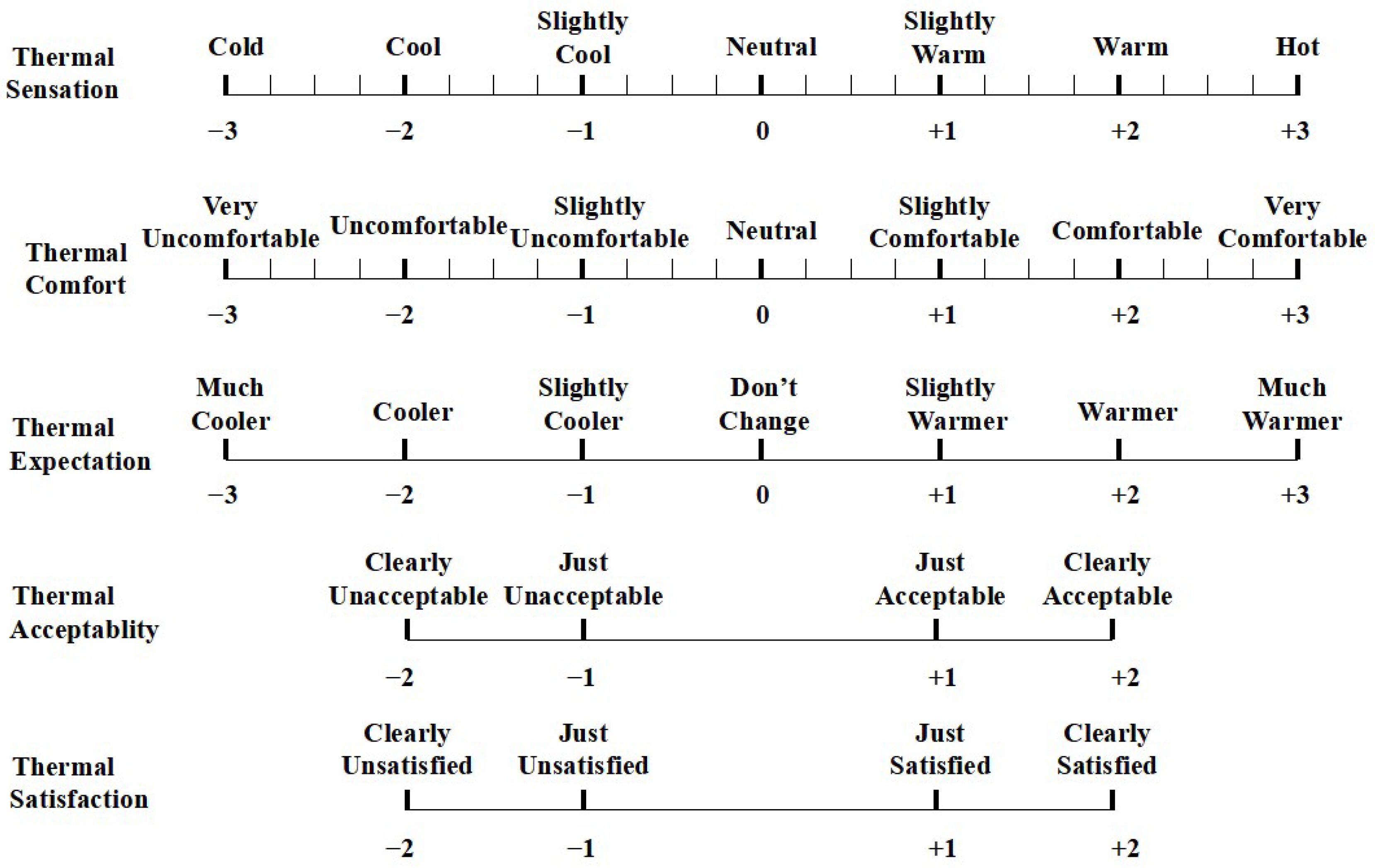
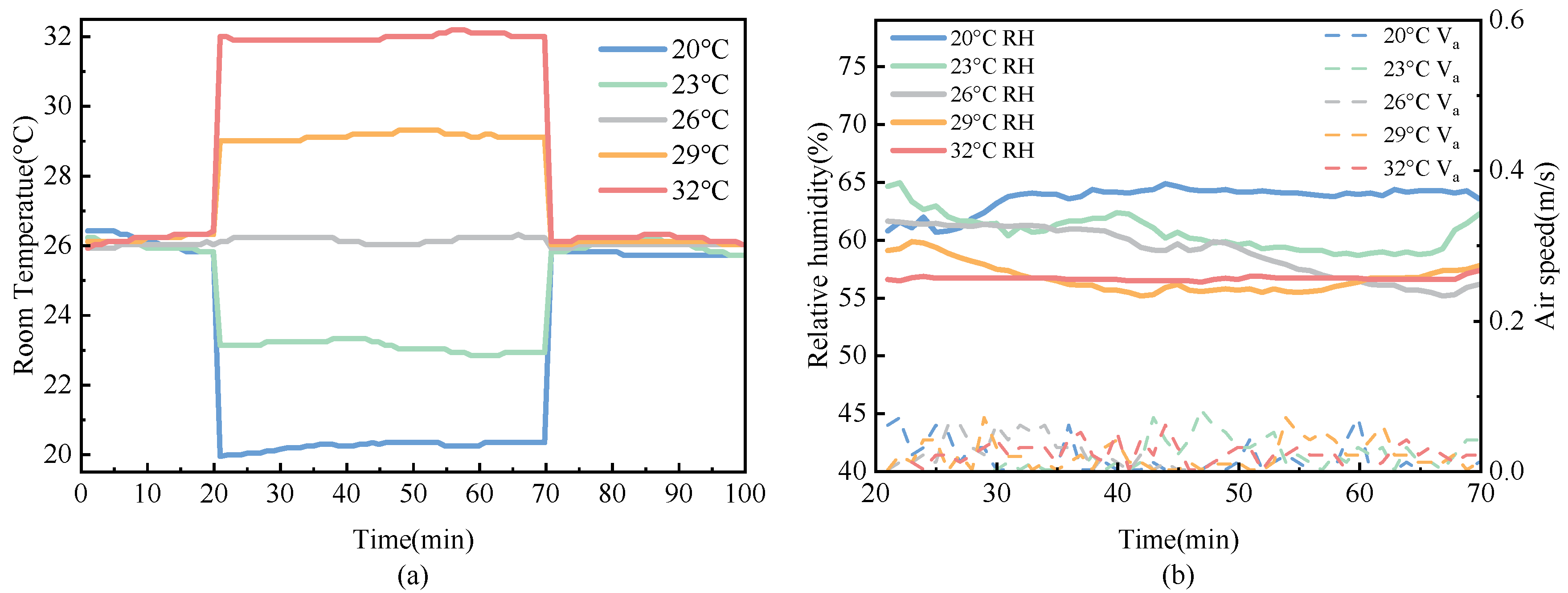




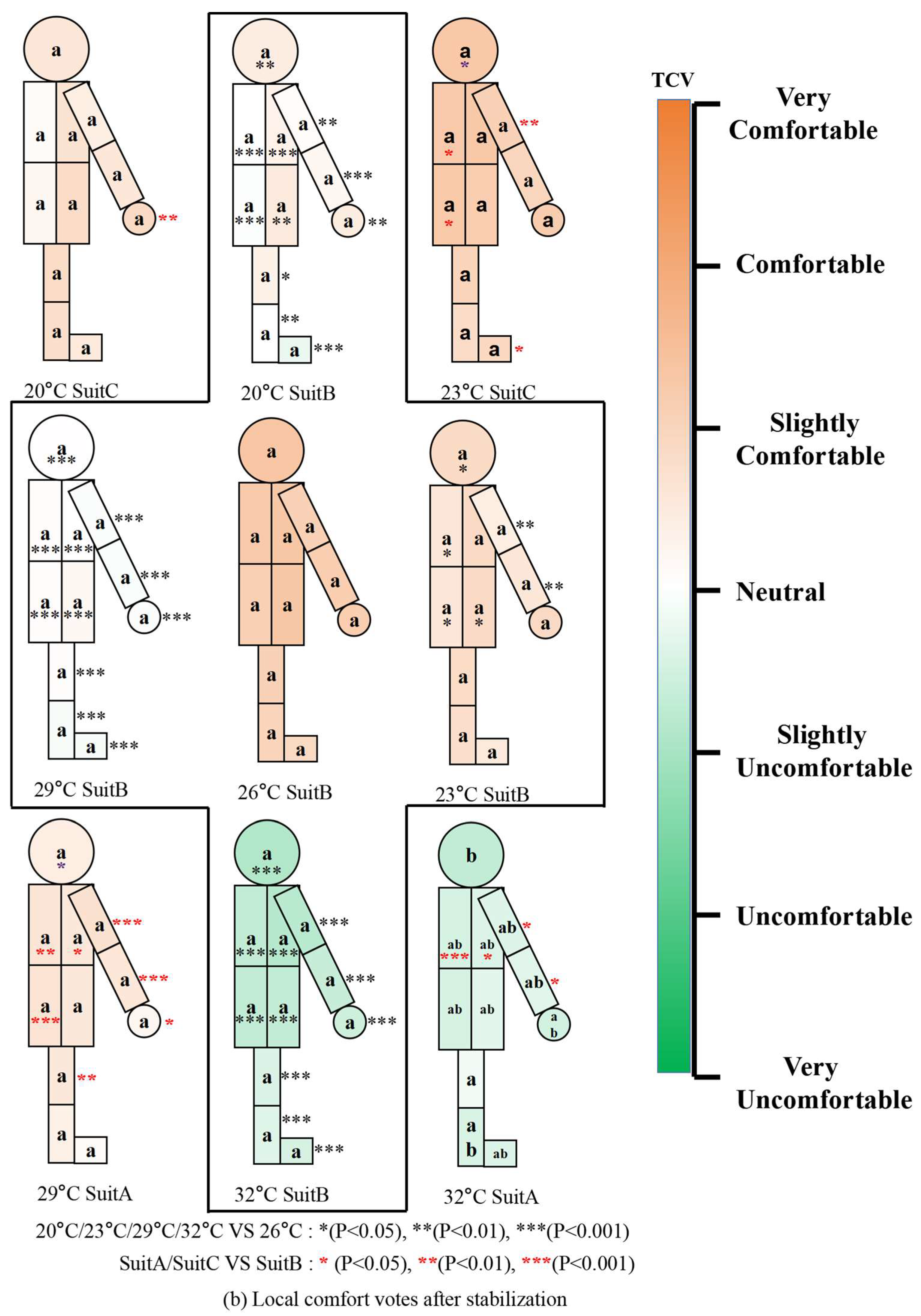
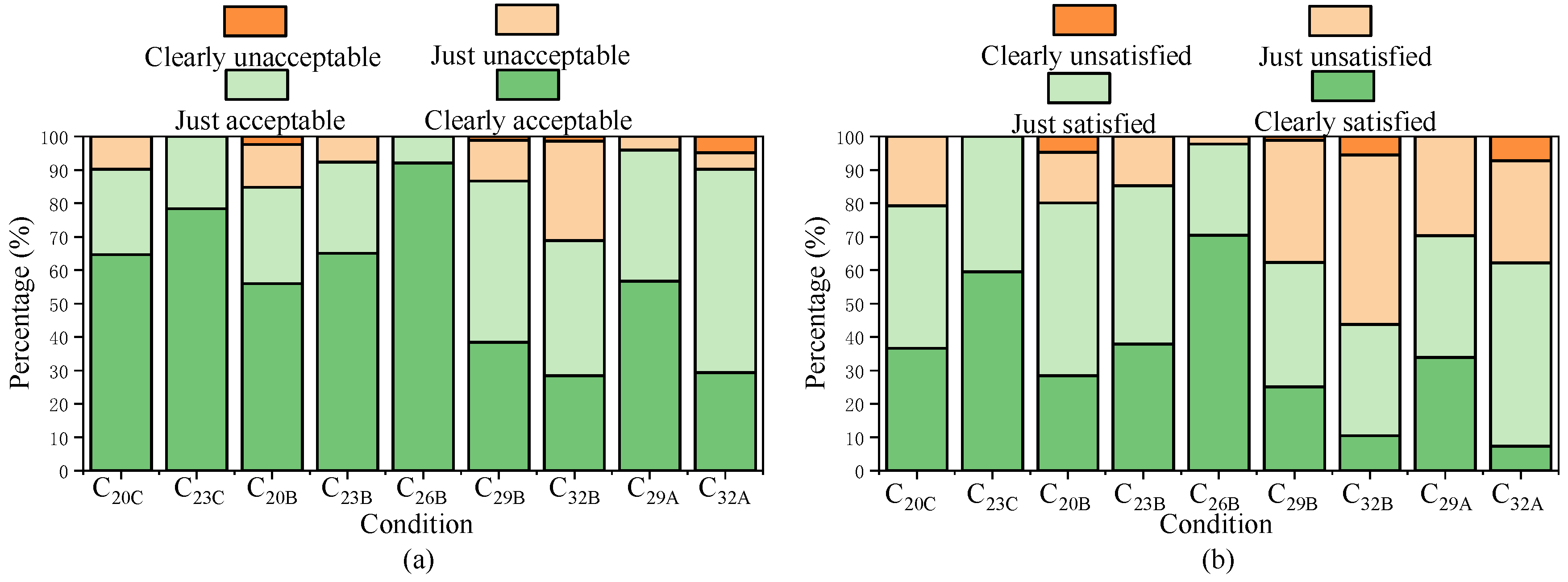
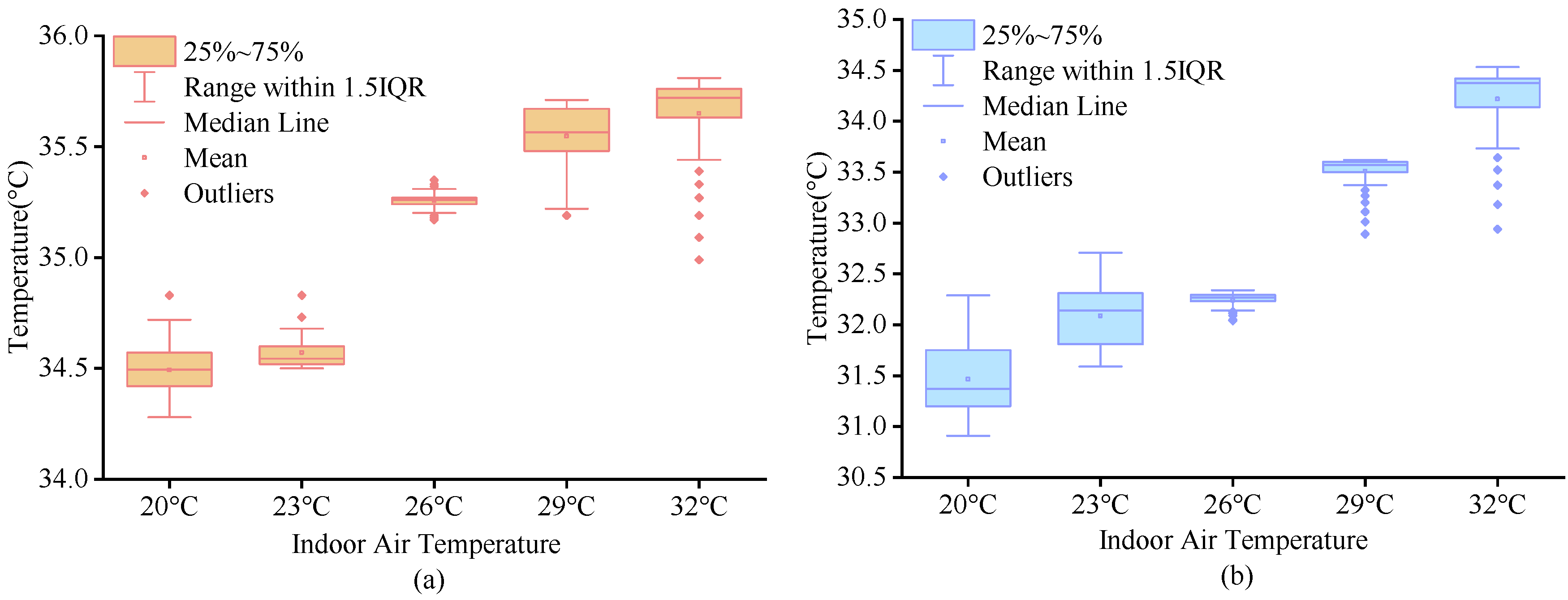

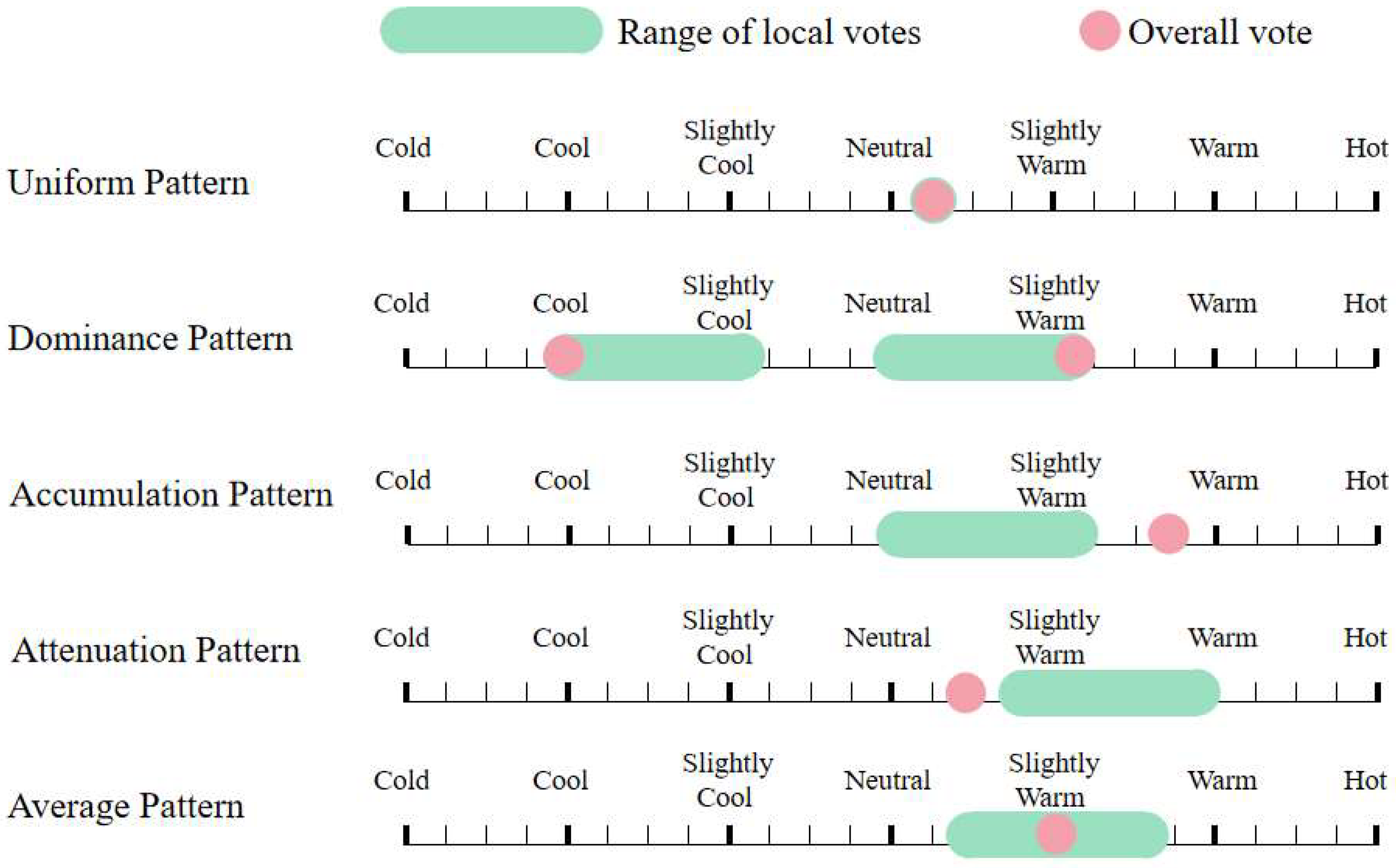
| Working Conditions | Abbreviation | Room Temperature | Suits | ||
|---|---|---|---|---|---|
| Suit A 0.37 clo | Suit B 0.59 clo | Suit C 0.77 clo | |||
| Condition 1 | C20C | 20 °C | √ | ||
| Condition 2 | C23C | 23 °C | √ | ||
| Condition 3 | C20B | 20 °C | √ | ||
| Condition 4 | C23B | 23 °C | √ | ||
| Condition 5 | C26B | 26 °C | √ | ||
| Condition 6 | C29B | 29 °C | √ | ||
| Condition 7 | C32B | 32 °C | √ | ||
| Condition 8 | C29A | 29 °C | √ | ||
| Condition 9 | C32A | 32 °C | √ | ||
| Gender | Sample Size | Age (Years) | Height (m) | Weight (kg) | BMI (kg/m2) |
|---|---|---|---|---|---|
| Male | 12 | 22.83 ± 3.01 | 173.08 ± 6.11 | 63.94 ± 6.13 | 21.34 ± 1.63 |
| Female | 20 | 22.4 ± 3.36 | 161.50 ± 5.20 | 56.95 ± 8.73 | 21.65 ± 3.06 |
| Overall | Head | Chest | Belly | Upper Back | Waist | Upper Arm | Forearm | Hand | Thigh | Calf | Foot | |
|---|---|---|---|---|---|---|---|---|---|---|---|---|
| C20C | 0.88 | 0.17 | 0.33 | 0.33 | 0.83 | 0.67 | 0.67 | 0.50 | 0.33 | 0.50 | 0.67 | 0.50 |
| C23C | 0.14 | 0.17 | 0.17 | 0.17 | 0.17 | 0.17 | 0.00 | 0.17 | −0.17 | 0.50 | 0.33 | −0.17 |
| C20B | 1.38 | 0.29 | 0.57 | 0.36 | 0.93 | 0.79 | 0.86 | 0.43 | 0.36 | 0.71 | 1.14 | 1.43 |
| C23B | 0.64 | −0.07 | 0.00 | 0.14 | 0.43 | 0.43 | 0.43 | 0.29 | −0.07 | 0.29 | 0.36 | 0.21 |
| C26B | 0.00 | −0.14 | 0.00 | 0.00 | 0.14 | 0.29 | −0.14 | 0.00 | −0.14 | 0.14 | 0.29 | 0.57 |
| C29B | −1.00 | −0.94 | −0.88 | −0.88 | −1.00 | −0.75 | −1.13 | −0.88 | −0.63 | −1.13 | −0.88 | −1.00 |
| C32B | −1.71 | −1.11 | −1.33 | −1.11 | −1.78 | −1.11 | −1.56 | −1.33 | −0.78 | −0.78 | −0.89 | −0.78 |
| C29A | −0.57 | −1.00 | −0.50 | −0.50 | −0.50 | −0.33 | −0.33 | −0.33 | −0.67 | −0.50 | −0.33 | −0.67 |
| C32A | −1.25 | −1.00 | −0.78 | −0.44 | −0.89 | −0.78 | −0.89 | −0.78 | −0.78 | −0.67 | −0.56 | −1.00 |
| Comfort Vote | Uniform | Accumulation | Attenuation | Dominance | Average | Total | ||
|---|---|---|---|---|---|---|---|---|
| Sensation Vote | Comfort-Accumulation | Discomfort-Accumulation | ||||||
| Uniform | 196 | 11 | 3 | 1 | 39 | 12 | 262 | |
| Accumulation | Warmth-accumulation | 2 | 1 | 5 | 0 | 13 | 3 | 24 |
| Coldness-accumulation | 7 | 2 | 17 | 0 | 17 | 5 | 48 | |
| Attenuation | 0 | 2 | 0 | 0 | 4 | 1 | 7 | |
| Dominance | 122 | 24 | 14 | 3 | 249 | 84 | 496 | |
| Average | 121 | 25 | 6 | 2 | 182 | 223 | 559 | |
| Total | 448 | 65 | 45 | 6 | 504 | 328 | 1396 | |
| Sensation Vote | Overall Sensation Vote | Local Sensation Vote | |
|---|---|---|---|
| Skin Temperature | |||
| Head | 0.704 ** | 0.616 ** | |
| Chest | 0.643 ** | 0.658 ** | |
| Belly | 0.563 ** | 0.530 ** | |
| Upper Back | 0.622 ** | 0.672 ** | |
| Waist | 0.543 ** | 0.494 ** | |
| Upper Arm | 0.568 ** | 0.607 ** | |
| Forearm | 0.591 ** | 0.515 ** | |
| Hand | 0.666 ** | 0.549 ** | |
| Thigh | 0.592 ** | 0.687 ** | |
| Calves | 0.647 ** | 0.618 ** | |
| Foot | 0.490 ** | 0.473 ** | |
Disclaimer/Publisher’s Note: The statements, opinions and data contained in all publications are solely those of the individual author(s) and contributor(s) and not of MDPI and/or the editor(s). MDPI and/or the editor(s) disclaim responsibility for any injury to people or property resulting from any ideas, methods, instructions or products referred to in the content. |
© 2023 by the authors. Licensee MDPI, Basel, Switzerland. This article is an open access article distributed under the terms and conditions of the Creative Commons Attribution (CC BY) license (https://creativecommons.org/licenses/by/4.0/).
Share and Cite
Zhong, X.; Yu, H.; Tang, Y.; Mao, H.; Zhang, K. Local Thermal Comfort and Physiological Responses in Uniform Environments. Buildings 2024, 14, 59. https://doi.org/10.3390/buildings14010059
Zhong X, Yu H, Tang Y, Mao H, Zhang K. Local Thermal Comfort and Physiological Responses in Uniform Environments. Buildings. 2024; 14(1):59. https://doi.org/10.3390/buildings14010059
Chicago/Turabian StyleZhong, Xianzhun, Hang Yu, Yin Tang, Huice Mao, and Kege Zhang. 2024. "Local Thermal Comfort and Physiological Responses in Uniform Environments" Buildings 14, no. 1: 59. https://doi.org/10.3390/buildings14010059








